MGT501 Business Environment: Woolworths Stakeholder Analysis Report
VerifiedAdded on 2022/09/22
|14
|3538
|28
Report
AI Summary
This report provides a detailed analysis of the business environment of Woolworths, a leading Australian retailing company. It examines the company's functional areas, including marketing, human resources, finance, operations, and customer service. The report identifies and assesses both internal stakeholders (employees, shareholders) and external stakeholders (customers, suppliers, government), evaluating their interests and influence. It applies stakeholder theory to understand the implications of conflicting interests and conducts a stakeholder analysis using a matrix and comparative analysis. The report concludes with insights into stakeholder engagement and its impact on Woolworths' business strategies.

Business Environment
Running Head: BUSINESS ENVIRONMENT 0
S t u d e n t N a m e :
S t u d e n t U n i v e r s i t y :
Woolworths
Running Head: BUSINESS ENVIRONMENT 0
S t u d e n t N a m e :
S t u d e n t U n i v e r s i t y :
Woolworths
Paraphrase This Document
Need a fresh take? Get an instant paraphrase of this document with our AI Paraphraser
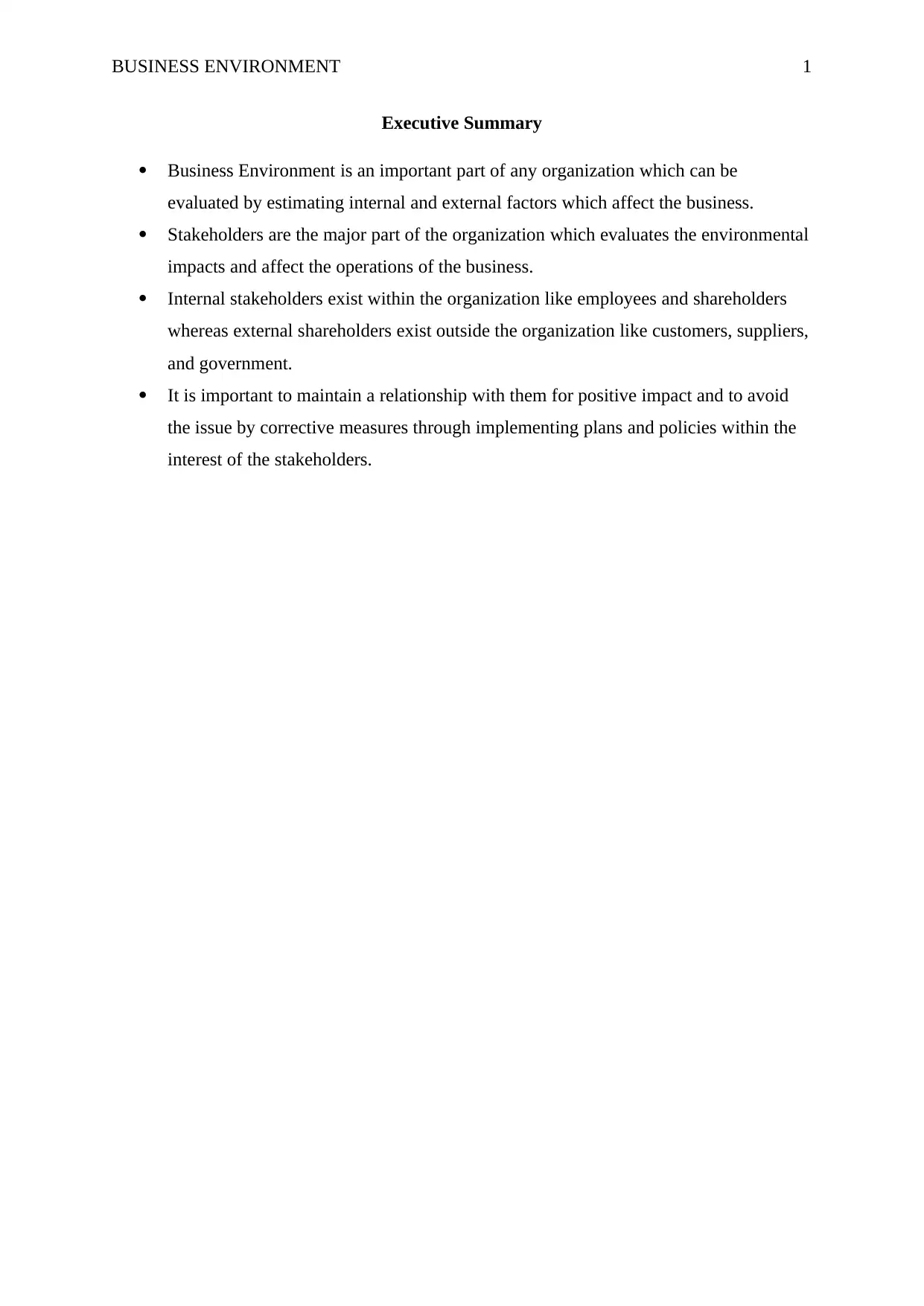
BUSINESS ENVIRONMENT 1
Executive Summary
Business Environment is an important part of any organization which can be
evaluated by estimating internal and external factors which affect the business.
Stakeholders are the major part of the organization which evaluates the environmental
impacts and affect the operations of the business.
Internal stakeholders exist within the organization like employees and shareholders
whereas external shareholders exist outside the organization like customers, suppliers,
and government.
It is important to maintain a relationship with them for positive impact and to avoid
the issue by corrective measures through implementing plans and policies within the
interest of the stakeholders.
Executive Summary
Business Environment is an important part of any organization which can be
evaluated by estimating internal and external factors which affect the business.
Stakeholders are the major part of the organization which evaluates the environmental
impacts and affect the operations of the business.
Internal stakeholders exist within the organization like employees and shareholders
whereas external shareholders exist outside the organization like customers, suppliers,
and government.
It is important to maintain a relationship with them for positive impact and to avoid
the issue by corrective measures through implementing plans and policies within the
interest of the stakeholders.
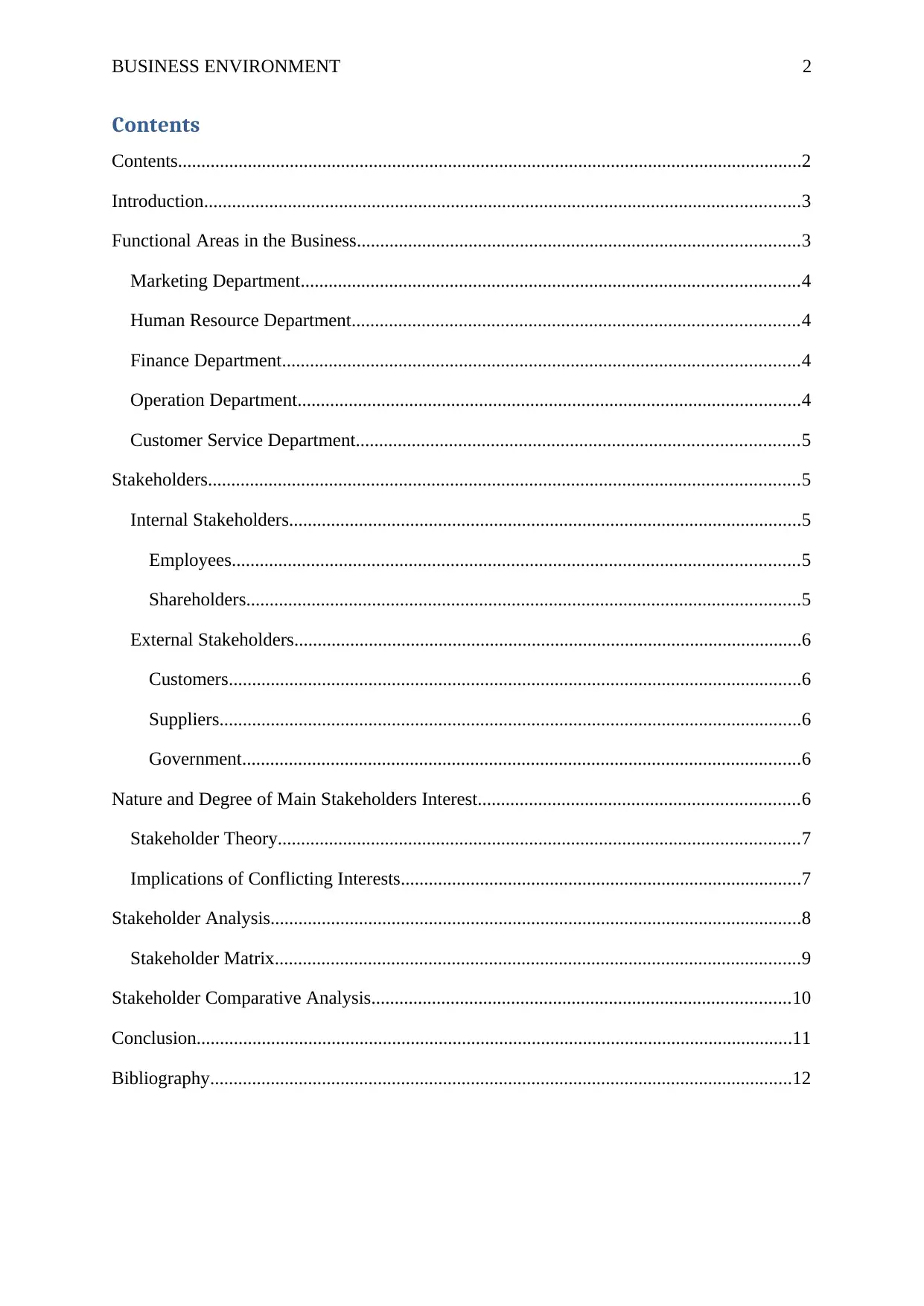
BUSINESS ENVIRONMENT 2
Contents
Contents......................................................................................................................................2
Introduction................................................................................................................................3
Functional Areas in the Business...............................................................................................3
Marketing Department...........................................................................................................4
Human Resource Department................................................................................................4
Finance Department...............................................................................................................4
Operation Department............................................................................................................4
Customer Service Department...............................................................................................5
Stakeholders...............................................................................................................................5
Internal Stakeholders..............................................................................................................5
Employees..........................................................................................................................5
Shareholders.......................................................................................................................5
External Stakeholders.............................................................................................................6
Customers...........................................................................................................................6
Suppliers.............................................................................................................................6
Government........................................................................................................................6
Nature and Degree of Main Stakeholders Interest.....................................................................6
Stakeholder Theory................................................................................................................7
Implications of Conflicting Interests......................................................................................7
Stakeholder Analysis..................................................................................................................8
Stakeholder Matrix.................................................................................................................9
Stakeholder Comparative Analysis..........................................................................................10
Conclusion................................................................................................................................11
Bibliography.............................................................................................................................12
Contents
Contents......................................................................................................................................2
Introduction................................................................................................................................3
Functional Areas in the Business...............................................................................................3
Marketing Department...........................................................................................................4
Human Resource Department................................................................................................4
Finance Department...............................................................................................................4
Operation Department............................................................................................................4
Customer Service Department...............................................................................................5
Stakeholders...............................................................................................................................5
Internal Stakeholders..............................................................................................................5
Employees..........................................................................................................................5
Shareholders.......................................................................................................................5
External Stakeholders.............................................................................................................6
Customers...........................................................................................................................6
Suppliers.............................................................................................................................6
Government........................................................................................................................6
Nature and Degree of Main Stakeholders Interest.....................................................................6
Stakeholder Theory................................................................................................................7
Implications of Conflicting Interests......................................................................................7
Stakeholder Analysis..................................................................................................................8
Stakeholder Matrix.................................................................................................................9
Stakeholder Comparative Analysis..........................................................................................10
Conclusion................................................................................................................................11
Bibliography.............................................................................................................................12
⊘ This is a preview!⊘
Do you want full access?
Subscribe today to unlock all pages.

Trusted by 1+ million students worldwide
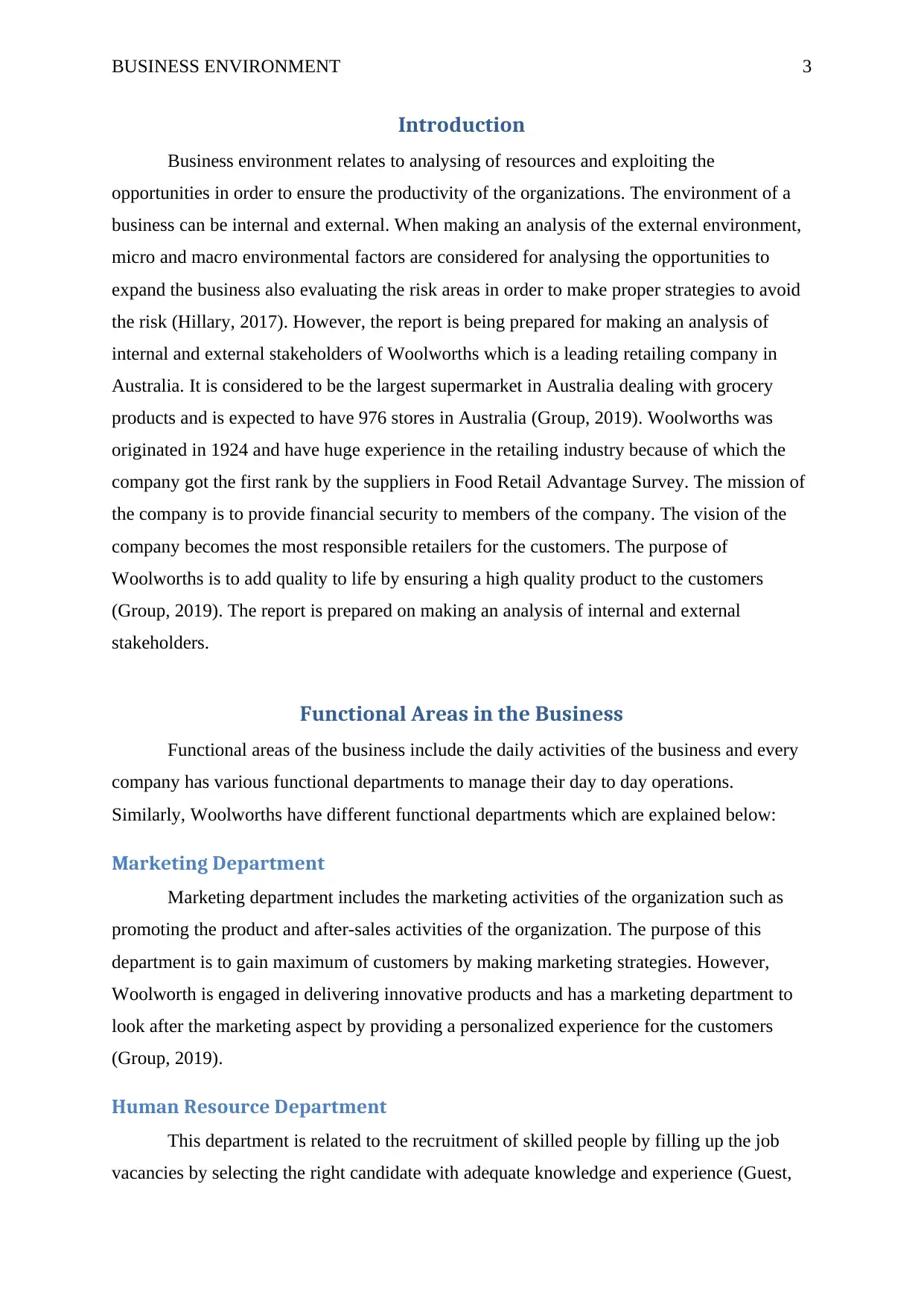
BUSINESS ENVIRONMENT 3
Introduction
Business environment relates to analysing of resources and exploiting the
opportunities in order to ensure the productivity of the organizations. The environment of a
business can be internal and external. When making an analysis of the external environment,
micro and macro environmental factors are considered for analysing the opportunities to
expand the business also evaluating the risk areas in order to make proper strategies to avoid
the risk (Hillary, 2017). However, the report is being prepared for making an analysis of
internal and external stakeholders of Woolworths which is a leading retailing company in
Australia. It is considered to be the largest supermarket in Australia dealing with grocery
products and is expected to have 976 stores in Australia (Group, 2019). Woolworths was
originated in 1924 and have huge experience in the retailing industry because of which the
company got the first rank by the suppliers in Food Retail Advantage Survey. The mission of
the company is to provide financial security to members of the company. The vision of the
company becomes the most responsible retailers for the customers. The purpose of
Woolworths is to add quality to life by ensuring a high quality product to the customers
(Group, 2019). The report is prepared on making an analysis of internal and external
stakeholders.
Functional Areas in the Business
Functional areas of the business include the daily activities of the business and every
company has various functional departments to manage their day to day operations.
Similarly, Woolworths have different functional departments which are explained below:
Marketing Department
Marketing department includes the marketing activities of the organization such as
promoting the product and after-sales activities of the organization. The purpose of this
department is to gain maximum of customers by making marketing strategies. However,
Woolworth is engaged in delivering innovative products and has a marketing department to
look after the marketing aspect by providing a personalized experience for the customers
(Group, 2019).
Human Resource Department
This department is related to the recruitment of skilled people by filling up the job
vacancies by selecting the right candidate with adequate knowledge and experience (Guest,
Introduction
Business environment relates to analysing of resources and exploiting the
opportunities in order to ensure the productivity of the organizations. The environment of a
business can be internal and external. When making an analysis of the external environment,
micro and macro environmental factors are considered for analysing the opportunities to
expand the business also evaluating the risk areas in order to make proper strategies to avoid
the risk (Hillary, 2017). However, the report is being prepared for making an analysis of
internal and external stakeholders of Woolworths which is a leading retailing company in
Australia. It is considered to be the largest supermarket in Australia dealing with grocery
products and is expected to have 976 stores in Australia (Group, 2019). Woolworths was
originated in 1924 and have huge experience in the retailing industry because of which the
company got the first rank by the suppliers in Food Retail Advantage Survey. The mission of
the company is to provide financial security to members of the company. The vision of the
company becomes the most responsible retailers for the customers. The purpose of
Woolworths is to add quality to life by ensuring a high quality product to the customers
(Group, 2019). The report is prepared on making an analysis of internal and external
stakeholders.
Functional Areas in the Business
Functional areas of the business include the daily activities of the business and every
company has various functional departments to manage their day to day operations.
Similarly, Woolworths have different functional departments which are explained below:
Marketing Department
Marketing department includes the marketing activities of the organization such as
promoting the product and after-sales activities of the organization. The purpose of this
department is to gain maximum of customers by making marketing strategies. However,
Woolworth is engaged in delivering innovative products and has a marketing department to
look after the marketing aspect by providing a personalized experience for the customers
(Group, 2019).
Human Resource Department
This department is related to the recruitment of skilled people by filling up the job
vacancies by selecting the right candidate with adequate knowledge and experience (Guest,
Paraphrase This Document
Need a fresh take? Get an instant paraphrase of this document with our AI Paraphraser
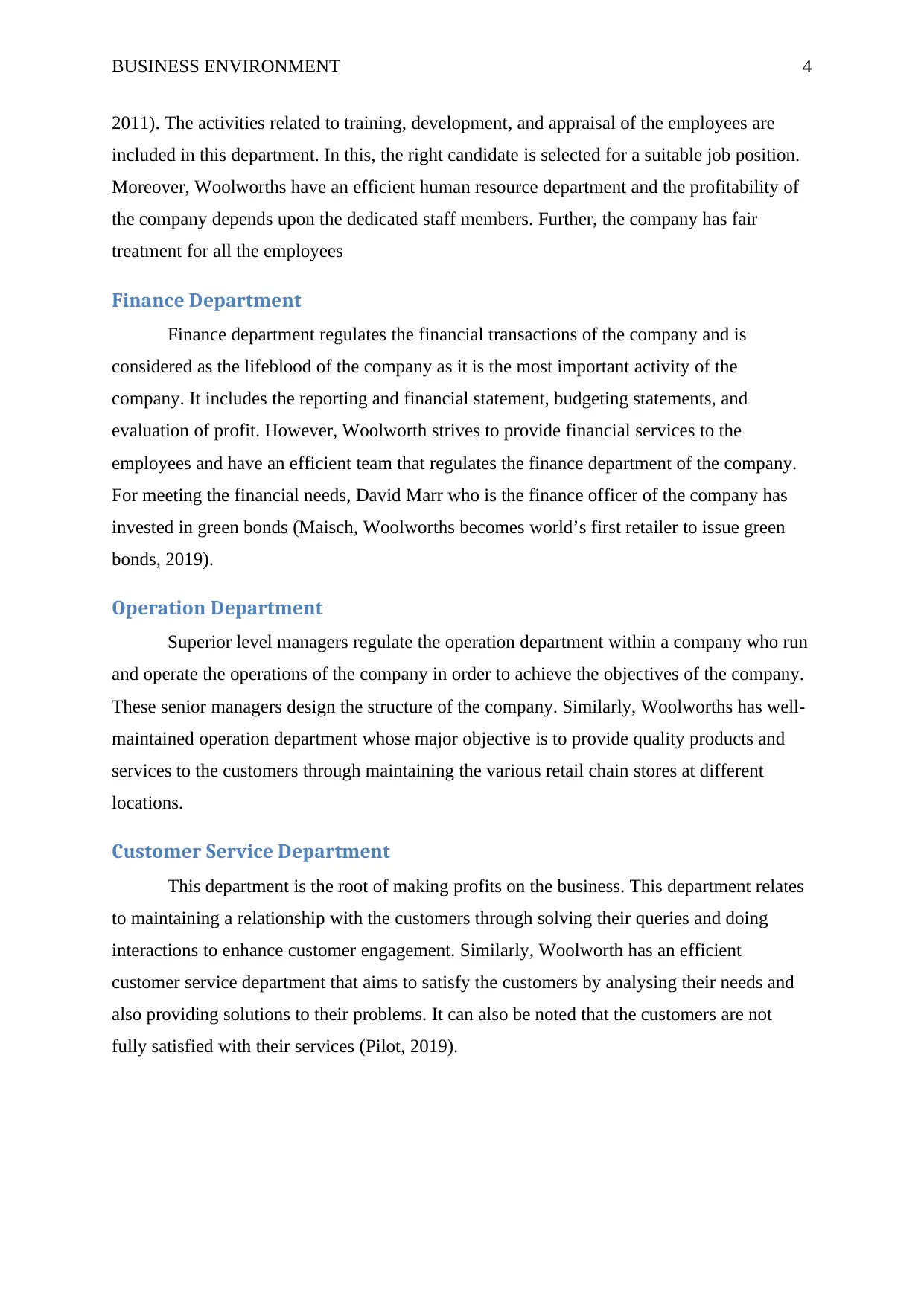
BUSINESS ENVIRONMENT 4
2011). The activities related to training, development, and appraisal of the employees are
included in this department. In this, the right candidate is selected for a suitable job position.
Moreover, Woolworths have an efficient human resource department and the profitability of
the company depends upon the dedicated staff members. Further, the company has fair
treatment for all the employees
Finance Department
Finance department regulates the financial transactions of the company and is
considered as the lifeblood of the company as it is the most important activity of the
company. It includes the reporting and financial statement, budgeting statements, and
evaluation of profit. However, Woolworth strives to provide financial services to the
employees and have an efficient team that regulates the finance department of the company.
For meeting the financial needs, David Marr who is the finance officer of the company has
invested in green bonds (Maisch, Woolworths becomes world’s first retailer to issue green
bonds, 2019).
Operation Department
Superior level managers regulate the operation department within a company who run
and operate the operations of the company in order to achieve the objectives of the company.
These senior managers design the structure of the company. Similarly, Woolworths has well-
maintained operation department whose major objective is to provide quality products and
services to the customers through maintaining the various retail chain stores at different
locations.
Customer Service Department
This department is the root of making profits on the business. This department relates
to maintaining a relationship with the customers through solving their queries and doing
interactions to enhance customer engagement. Similarly, Woolworth has an efficient
customer service department that aims to satisfy the customers by analysing their needs and
also providing solutions to their problems. It can also be noted that the customers are not
fully satisfied with their services (Pilot, 2019).
2011). The activities related to training, development, and appraisal of the employees are
included in this department. In this, the right candidate is selected for a suitable job position.
Moreover, Woolworths have an efficient human resource department and the profitability of
the company depends upon the dedicated staff members. Further, the company has fair
treatment for all the employees
Finance Department
Finance department regulates the financial transactions of the company and is
considered as the lifeblood of the company as it is the most important activity of the
company. It includes the reporting and financial statement, budgeting statements, and
evaluation of profit. However, Woolworth strives to provide financial services to the
employees and have an efficient team that regulates the finance department of the company.
For meeting the financial needs, David Marr who is the finance officer of the company has
invested in green bonds (Maisch, Woolworths becomes world’s first retailer to issue green
bonds, 2019).
Operation Department
Superior level managers regulate the operation department within a company who run
and operate the operations of the company in order to achieve the objectives of the company.
These senior managers design the structure of the company. Similarly, Woolworths has well-
maintained operation department whose major objective is to provide quality products and
services to the customers through maintaining the various retail chain stores at different
locations.
Customer Service Department
This department is the root of making profits on the business. This department relates
to maintaining a relationship with the customers through solving their queries and doing
interactions to enhance customer engagement. Similarly, Woolworth has an efficient
customer service department that aims to satisfy the customers by analysing their needs and
also providing solutions to their problems. It can also be noted that the customers are not
fully satisfied with their services (Pilot, 2019).
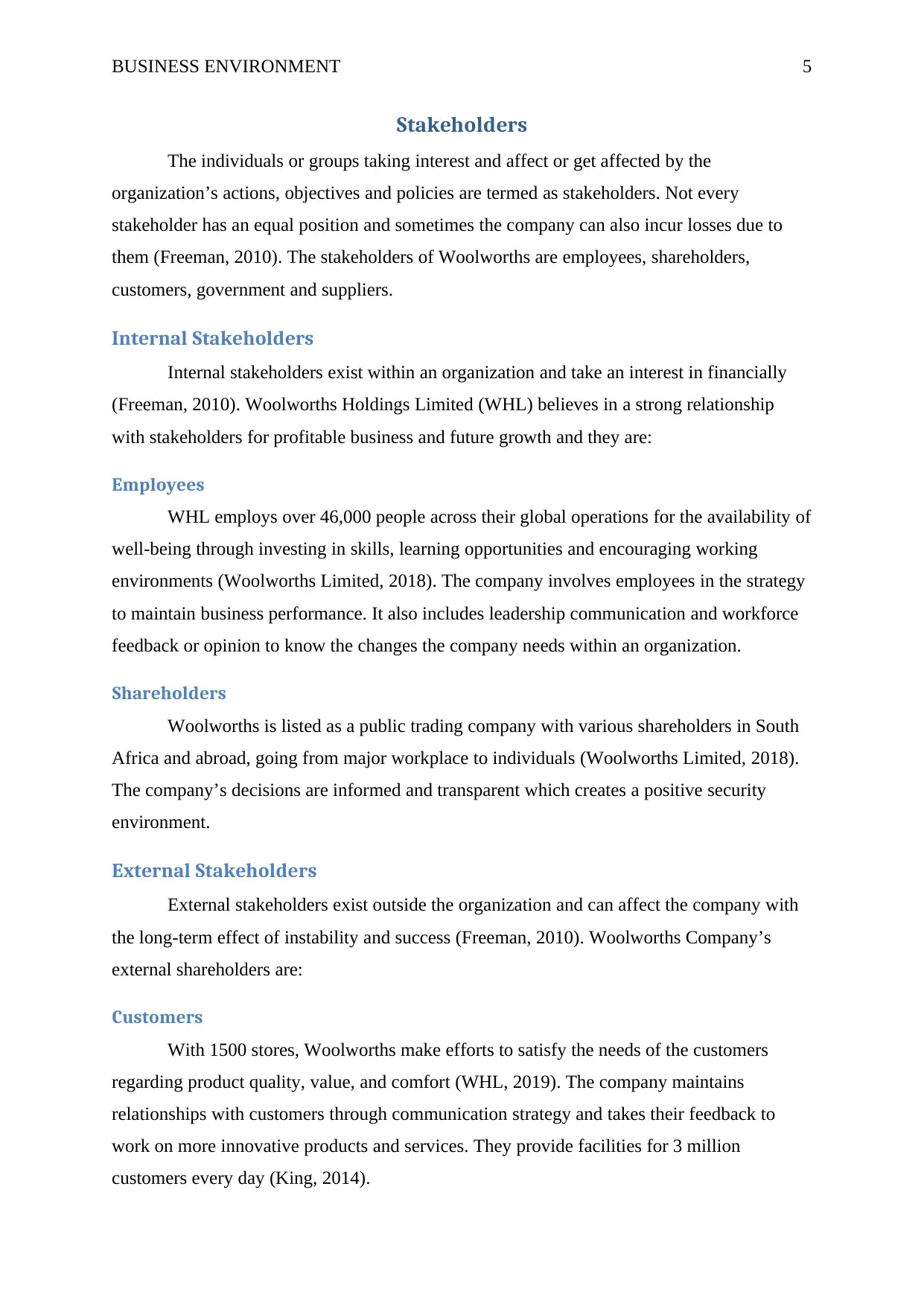
BUSINESS ENVIRONMENT 5
Stakeholders
The individuals or groups taking interest and affect or get affected by the
organization’s actions, objectives and policies are termed as stakeholders. Not every
stakeholder has an equal position and sometimes the company can also incur losses due to
them (Freeman, 2010). The stakeholders of Woolworths are employees, shareholders,
customers, government and suppliers.
Internal Stakeholders
Internal stakeholders exist within an organization and take an interest in financially
(Freeman, 2010). Woolworths Holdings Limited (WHL) believes in a strong relationship
with stakeholders for profitable business and future growth and they are:
Employees
WHL employs over 46,000 people across their global operations for the availability of
well-being through investing in skills, learning opportunities and encouraging working
environments (Woolworths Limited, 2018). The company involves employees in the strategy
to maintain business performance. It also includes leadership communication and workforce
feedback or opinion to know the changes the company needs within an organization.
Shareholders
Woolworths is listed as a public trading company with various shareholders in South
Africa and abroad, going from major workplace to individuals (Woolworths Limited, 2018).
The company’s decisions are informed and transparent which creates a positive security
environment.
External Stakeholders
External stakeholders exist outside the organization and can affect the company with
the long-term effect of instability and success (Freeman, 2010). Woolworths Company’s
external shareholders are:
Customers
With 1500 stores, Woolworths make efforts to satisfy the needs of the customers
regarding product quality, value, and comfort (WHL, 2019). The company maintains
relationships with customers through communication strategy and takes their feedback to
work on more innovative products and services. They provide facilities for 3 million
customers every day (King, 2014).
Stakeholders
The individuals or groups taking interest and affect or get affected by the
organization’s actions, objectives and policies are termed as stakeholders. Not every
stakeholder has an equal position and sometimes the company can also incur losses due to
them (Freeman, 2010). The stakeholders of Woolworths are employees, shareholders,
customers, government and suppliers.
Internal Stakeholders
Internal stakeholders exist within an organization and take an interest in financially
(Freeman, 2010). Woolworths Holdings Limited (WHL) believes in a strong relationship
with stakeholders for profitable business and future growth and they are:
Employees
WHL employs over 46,000 people across their global operations for the availability of
well-being through investing in skills, learning opportunities and encouraging working
environments (Woolworths Limited, 2018). The company involves employees in the strategy
to maintain business performance. It also includes leadership communication and workforce
feedback or opinion to know the changes the company needs within an organization.
Shareholders
Woolworths is listed as a public trading company with various shareholders in South
Africa and abroad, going from major workplace to individuals (Woolworths Limited, 2018).
The company’s decisions are informed and transparent which creates a positive security
environment.
External Stakeholders
External stakeholders exist outside the organization and can affect the company with
the long-term effect of instability and success (Freeman, 2010). Woolworths Company’s
external shareholders are:
Customers
With 1500 stores, Woolworths make efforts to satisfy the needs of the customers
regarding product quality, value, and comfort (WHL, 2019). The company maintains
relationships with customers through communication strategy and takes their feedback to
work on more innovative products and services. They provide facilities for 3 million
customers every day (King, 2014).
⊘ This is a preview!⊘
Do you want full access?
Subscribe today to unlock all pages.

Trusted by 1+ million students worldwide
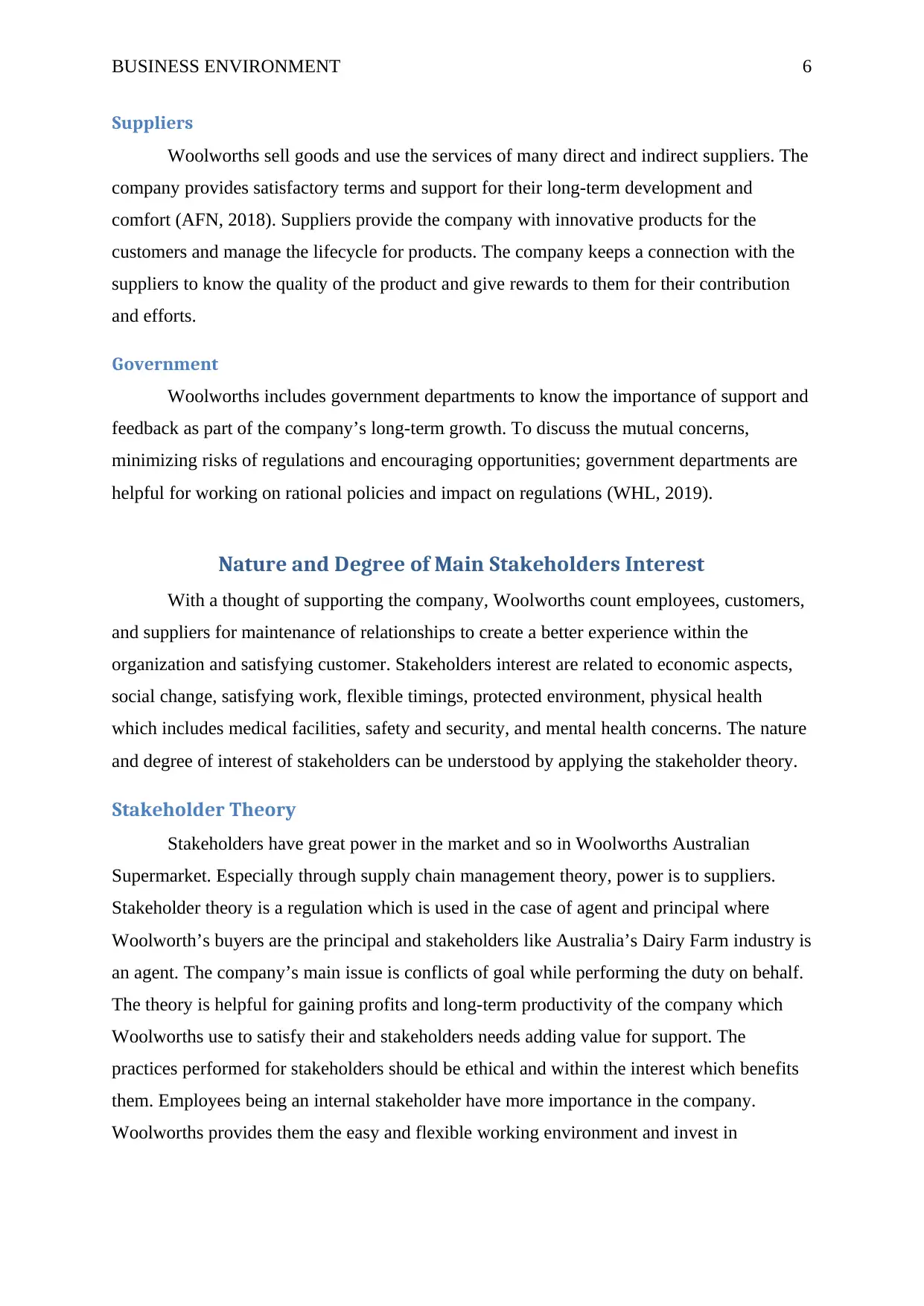
BUSINESS ENVIRONMENT 6
Suppliers
Woolworths sell goods and use the services of many direct and indirect suppliers. The
company provides satisfactory terms and support for their long-term development and
comfort (AFN, 2018). Suppliers provide the company with innovative products for the
customers and manage the lifecycle for products. The company keeps a connection with the
suppliers to know the quality of the product and give rewards to them for their contribution
and efforts.
Government
Woolworths includes government departments to know the importance of support and
feedback as part of the company’s long-term growth. To discuss the mutual concerns,
minimizing risks of regulations and encouraging opportunities; government departments are
helpful for working on rational policies and impact on regulations (WHL, 2019).
Nature and Degree of Main Stakeholders Interest
With a thought of supporting the company, Woolworths count employees, customers,
and suppliers for maintenance of relationships to create a better experience within the
organization and satisfying customer. Stakeholders interest are related to economic aspects,
social change, satisfying work, flexible timings, protected environment, physical health
which includes medical facilities, safety and security, and mental health concerns. The nature
and degree of interest of stakeholders can be understood by applying the stakeholder theory.
Stakeholder Theory
Stakeholders have great power in the market and so in Woolworths Australian
Supermarket. Especially through supply chain management theory, power is to suppliers.
Stakeholder theory is a regulation which is used in the case of agent and principal where
Woolworth’s buyers are the principal and stakeholders like Australia’s Dairy Farm industry is
an agent. The company’s main issue is conflicts of goal while performing the duty on behalf.
The theory is helpful for gaining profits and long-term productivity of the company which
Woolworths use to satisfy their and stakeholders needs adding value for support. The
practices performed for stakeholders should be ethical and within the interest which benefits
them. Employees being an internal stakeholder have more importance in the company.
Woolworths provides them the easy and flexible working environment and invest in
Suppliers
Woolworths sell goods and use the services of many direct and indirect suppliers. The
company provides satisfactory terms and support for their long-term development and
comfort (AFN, 2018). Suppliers provide the company with innovative products for the
customers and manage the lifecycle for products. The company keeps a connection with the
suppliers to know the quality of the product and give rewards to them for their contribution
and efforts.
Government
Woolworths includes government departments to know the importance of support and
feedback as part of the company’s long-term growth. To discuss the mutual concerns,
minimizing risks of regulations and encouraging opportunities; government departments are
helpful for working on rational policies and impact on regulations (WHL, 2019).
Nature and Degree of Main Stakeholders Interest
With a thought of supporting the company, Woolworths count employees, customers,
and suppliers for maintenance of relationships to create a better experience within the
organization and satisfying customer. Stakeholders interest are related to economic aspects,
social change, satisfying work, flexible timings, protected environment, physical health
which includes medical facilities, safety and security, and mental health concerns. The nature
and degree of interest of stakeholders can be understood by applying the stakeholder theory.
Stakeholder Theory
Stakeholders have great power in the market and so in Woolworths Australian
Supermarket. Especially through supply chain management theory, power is to suppliers.
Stakeholder theory is a regulation which is used in the case of agent and principal where
Woolworth’s buyers are the principal and stakeholders like Australia’s Dairy Farm industry is
an agent. The company’s main issue is conflicts of goal while performing the duty on behalf.
The theory is helpful for gaining profits and long-term productivity of the company which
Woolworths use to satisfy their and stakeholders needs adding value for support. The
practices performed for stakeholders should be ethical and within the interest which benefits
them. Employees being an internal stakeholder have more importance in the company.
Woolworths provides them the easy and flexible working environment and invest in
Paraphrase This Document
Need a fresh take? Get an instant paraphrase of this document with our AI Paraphraser
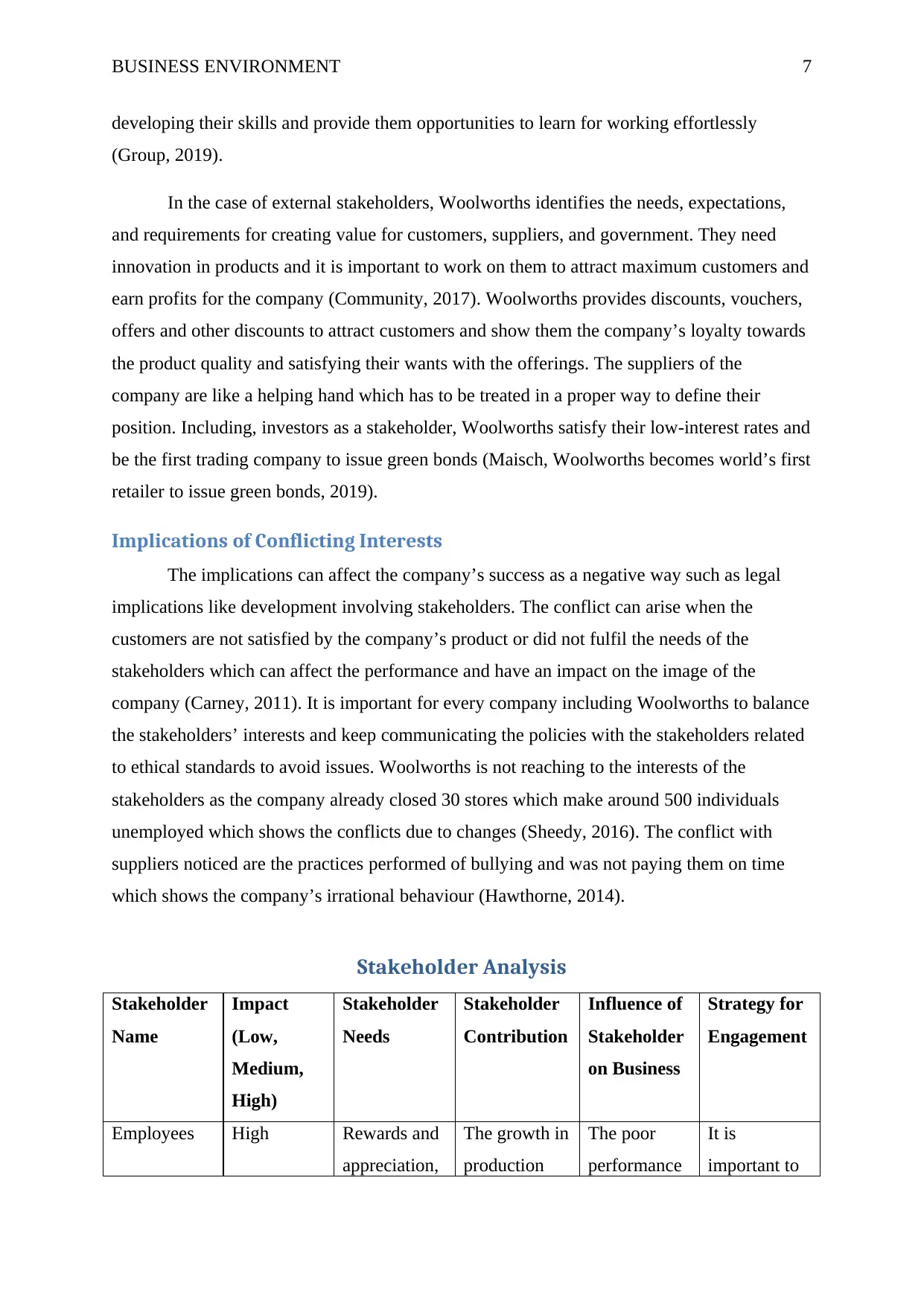
BUSINESS ENVIRONMENT 7
developing their skills and provide them opportunities to learn for working effortlessly
(Group, 2019).
In the case of external stakeholders, Woolworths identifies the needs, expectations,
and requirements for creating value for customers, suppliers, and government. They need
innovation in products and it is important to work on them to attract maximum customers and
earn profits for the company (Community, 2017). Woolworths provides discounts, vouchers,
offers and other discounts to attract customers and show them the company’s loyalty towards
the product quality and satisfying their wants with the offerings. The suppliers of the
company are like a helping hand which has to be treated in a proper way to define their
position. Including, investors as a stakeholder, Woolworths satisfy their low-interest rates and
be the first trading company to issue green bonds (Maisch, Woolworths becomes world’s first
retailer to issue green bonds, 2019).
Implications of Conflicting Interests
The implications can affect the company’s success as a negative way such as legal
implications like development involving stakeholders. The conflict can arise when the
customers are not satisfied by the company’s product or did not fulfil the needs of the
stakeholders which can affect the performance and have an impact on the image of the
company (Carney, 2011). It is important for every company including Woolworths to balance
the stakeholders’ interests and keep communicating the policies with the stakeholders related
to ethical standards to avoid issues. Woolworths is not reaching to the interests of the
stakeholders as the company already closed 30 stores which make around 500 individuals
unemployed which shows the conflicts due to changes (Sheedy, 2016). The conflict with
suppliers noticed are the practices performed of bullying and was not paying them on time
which shows the company’s irrational behaviour (Hawthorne, 2014).
Stakeholder Analysis
Stakeholder
Name
Impact
(Low,
Medium,
High)
Stakeholder
Needs
Stakeholder
Contribution
Influence of
Stakeholder
on Business
Strategy for
Engagement
Employees High Rewards and
appreciation,
The growth in
production
The poor
performance
It is
important to
developing their skills and provide them opportunities to learn for working effortlessly
(Group, 2019).
In the case of external stakeholders, Woolworths identifies the needs, expectations,
and requirements for creating value for customers, suppliers, and government. They need
innovation in products and it is important to work on them to attract maximum customers and
earn profits for the company (Community, 2017). Woolworths provides discounts, vouchers,
offers and other discounts to attract customers and show them the company’s loyalty towards
the product quality and satisfying their wants with the offerings. The suppliers of the
company are like a helping hand which has to be treated in a proper way to define their
position. Including, investors as a stakeholder, Woolworths satisfy their low-interest rates and
be the first trading company to issue green bonds (Maisch, Woolworths becomes world’s first
retailer to issue green bonds, 2019).
Implications of Conflicting Interests
The implications can affect the company’s success as a negative way such as legal
implications like development involving stakeholders. The conflict can arise when the
customers are not satisfied by the company’s product or did not fulfil the needs of the
stakeholders which can affect the performance and have an impact on the image of the
company (Carney, 2011). It is important for every company including Woolworths to balance
the stakeholders’ interests and keep communicating the policies with the stakeholders related
to ethical standards to avoid issues. Woolworths is not reaching to the interests of the
stakeholders as the company already closed 30 stores which make around 500 individuals
unemployed which shows the conflicts due to changes (Sheedy, 2016). The conflict with
suppliers noticed are the practices performed of bullying and was not paying them on time
which shows the company’s irrational behaviour (Hawthorne, 2014).
Stakeholder Analysis
Stakeholder
Name
Impact
(Low,
Medium,
High)
Stakeholder
Needs
Stakeholder
Contribution
Influence of
Stakeholder
on Business
Strategy for
Engagement
Employees High Rewards and
appreciation,
The growth in
production
The poor
performance
It is
important to
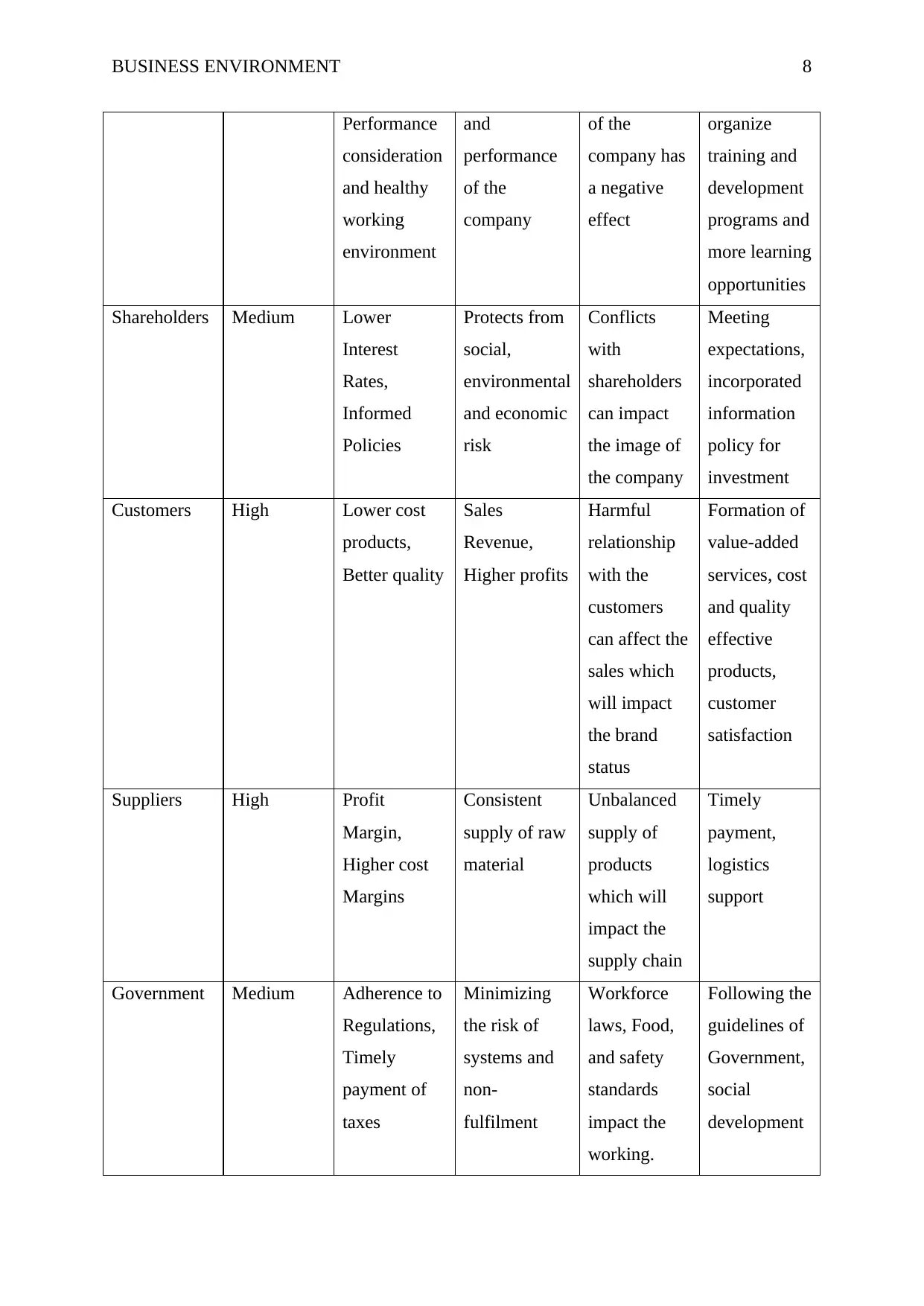
BUSINESS ENVIRONMENT 8
Performance
consideration
and healthy
working
environment
and
performance
of the
company
of the
company has
a negative
effect
organize
training and
development
programs and
more learning
opportunities
Shareholders Medium Lower
Interest
Rates,
Informed
Policies
Protects from
social,
environmental
and economic
risk
Conflicts
with
shareholders
can impact
the image of
the company
Meeting
expectations,
incorporated
information
policy for
investment
Customers High Lower cost
products,
Better quality
Sales
Revenue,
Higher profits
Harmful
relationship
with the
customers
can affect the
sales which
will impact
the brand
status
Formation of
value-added
services, cost
and quality
effective
products,
customer
satisfaction
Suppliers High Profit
Margin,
Higher cost
Margins
Consistent
supply of raw
material
Unbalanced
supply of
products
which will
impact the
supply chain
Timely
payment,
logistics
support
Government Medium Adherence to
Regulations,
Timely
payment of
taxes
Minimizing
the risk of
systems and
non-
fulfilment
Workforce
laws, Food,
and safety
standards
impact the
working.
Following the
guidelines of
Government,
social
development
Performance
consideration
and healthy
working
environment
and
performance
of the
company
of the
company has
a negative
effect
organize
training and
development
programs and
more learning
opportunities
Shareholders Medium Lower
Interest
Rates,
Informed
Policies
Protects from
social,
environmental
and economic
risk
Conflicts
with
shareholders
can impact
the image of
the company
Meeting
expectations,
incorporated
information
policy for
investment
Customers High Lower cost
products,
Better quality
Sales
Revenue,
Higher profits
Harmful
relationship
with the
customers
can affect the
sales which
will impact
the brand
status
Formation of
value-added
services, cost
and quality
effective
products,
customer
satisfaction
Suppliers High Profit
Margin,
Higher cost
Margins
Consistent
supply of raw
material
Unbalanced
supply of
products
which will
impact the
supply chain
Timely
payment,
logistics
support
Government Medium Adherence to
Regulations,
Timely
payment of
taxes
Minimizing
the risk of
systems and
non-
fulfilment
Workforce
laws, Food,
and safety
standards
impact the
working.
Following the
guidelines of
Government,
social
development
⊘ This is a preview!⊘
Do you want full access?
Subscribe today to unlock all pages.

Trusted by 1+ million students worldwide
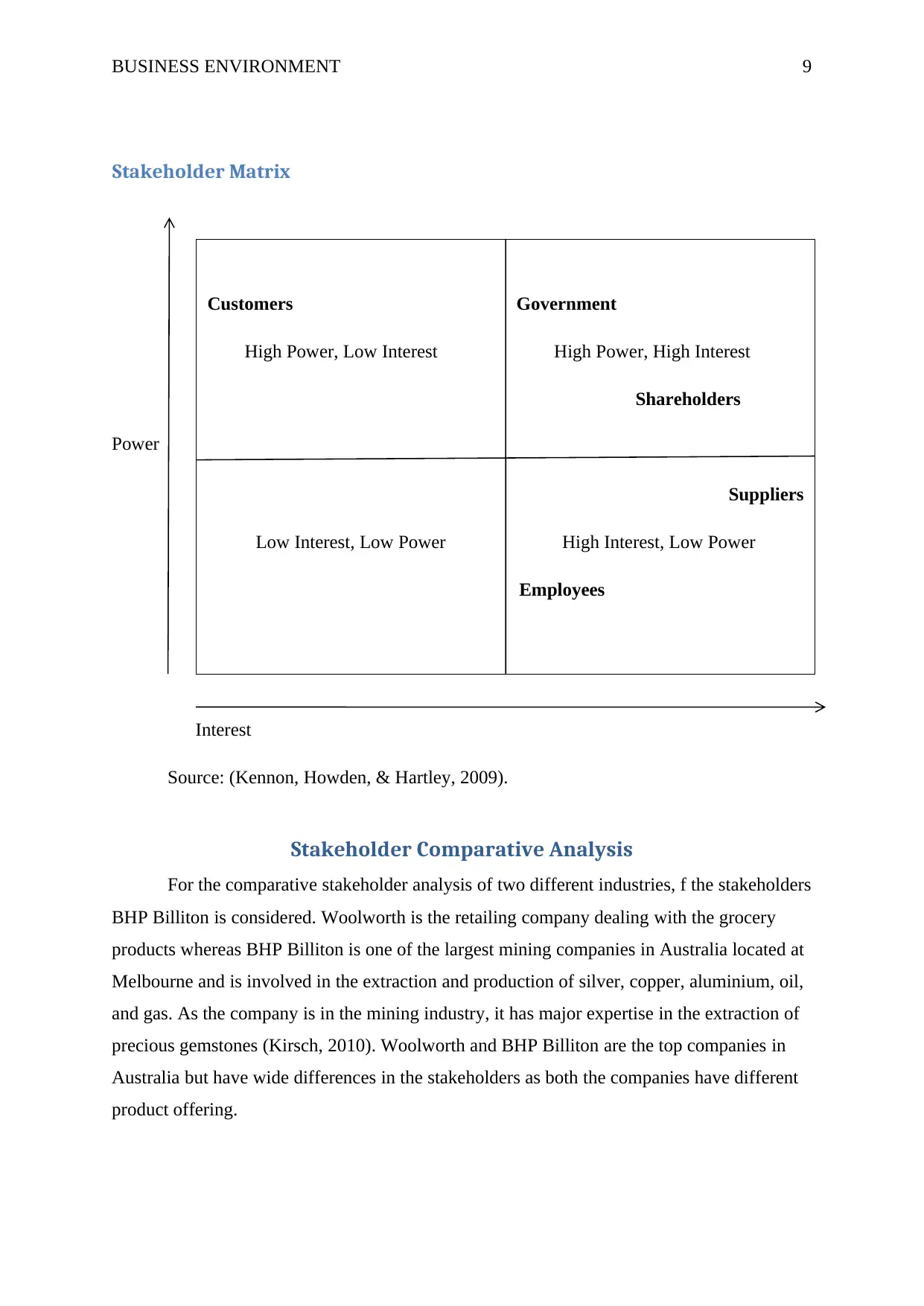
BUSINESS ENVIRONMENT 9
Stakeholder Matrix
Power
Interest
Source: (Kennon, Howden, & Hartley, 2009).
Stakeholder Comparative Analysis
For the comparative stakeholder analysis of two different industries, f the stakeholders
BHP Billiton is considered. Woolworth is the retailing company dealing with the grocery
products whereas BHP Billiton is one of the largest mining companies in Australia located at
Melbourne and is involved in the extraction and production of silver, copper, aluminium, oil,
and gas. As the company is in the mining industry, it has major expertise in the extraction of
precious gemstones (Kirsch, 2010). Woolworth and BHP Billiton are the top companies in
Australia but have wide differences in the stakeholders as both the companies have different
product offering.
Customers Government
High Power, Low Interest High Power, High Interest
Shareholders
Suppliers
Low Interest, Low Power High Interest, Low Power
Employees
Stakeholder Matrix
Power
Interest
Source: (Kennon, Howden, & Hartley, 2009).
Stakeholder Comparative Analysis
For the comparative stakeholder analysis of two different industries, f the stakeholders
BHP Billiton is considered. Woolworth is the retailing company dealing with the grocery
products whereas BHP Billiton is one of the largest mining companies in Australia located at
Melbourne and is involved in the extraction and production of silver, copper, aluminium, oil,
and gas. As the company is in the mining industry, it has major expertise in the extraction of
precious gemstones (Kirsch, 2010). Woolworth and BHP Billiton are the top companies in
Australia but have wide differences in the stakeholders as both the companies have different
product offering.
Customers Government
High Power, Low Interest High Power, High Interest
Shareholders
Suppliers
Low Interest, Low Power High Interest, Low Power
Employees
Paraphrase This Document
Need a fresh take? Get an instant paraphrase of this document with our AI Paraphraser
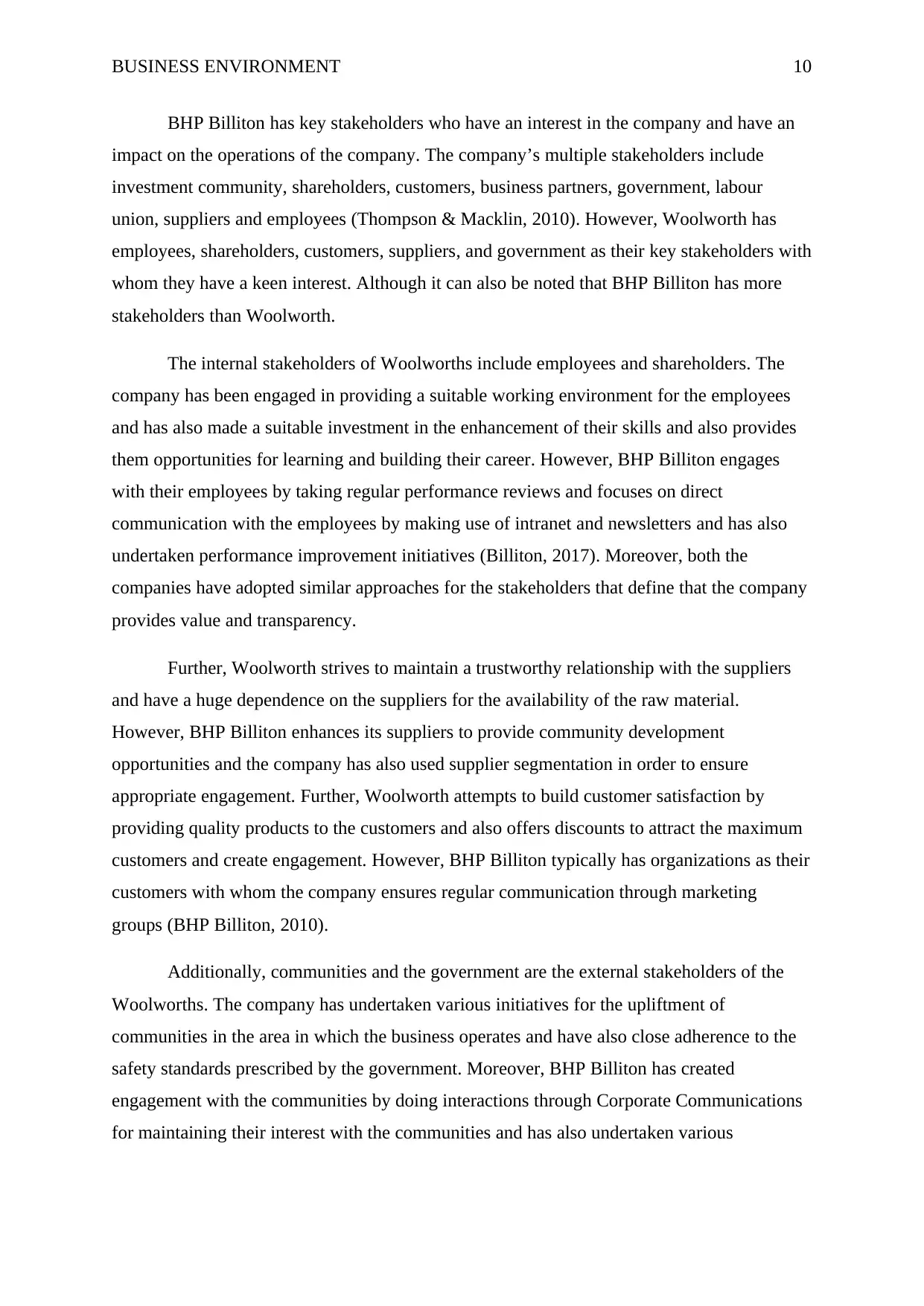
BUSINESS ENVIRONMENT 10
BHP Billiton has key stakeholders who have an interest in the company and have an
impact on the operations of the company. The company’s multiple stakeholders include
investment community, shareholders, customers, business partners, government, labour
union, suppliers and employees (Thompson & Macklin, 2010). However, Woolworth has
employees, shareholders, customers, suppliers, and government as their key stakeholders with
whom they have a keen interest. Although it can also be noted that BHP Billiton has more
stakeholders than Woolworth.
The internal stakeholders of Woolworths include employees and shareholders. The
company has been engaged in providing a suitable working environment for the employees
and has also made a suitable investment in the enhancement of their skills and also provides
them opportunities for learning and building their career. However, BHP Billiton engages
with their employees by taking regular performance reviews and focuses on direct
communication with the employees by making use of intranet and newsletters and has also
undertaken performance improvement initiatives (Billiton, 2017). Moreover, both the
companies have adopted similar approaches for the stakeholders that define that the company
provides value and transparency.
Further, Woolworth strives to maintain a trustworthy relationship with the suppliers
and have a huge dependence on the suppliers for the availability of the raw material.
However, BHP Billiton enhances its suppliers to provide community development
opportunities and the company has also used supplier segmentation in order to ensure
appropriate engagement. Further, Woolworth attempts to build customer satisfaction by
providing quality products to the customers and also offers discounts to attract the maximum
customers and create engagement. However, BHP Billiton typically has organizations as their
customers with whom the company ensures regular communication through marketing
groups (BHP Billiton, 2010).
Additionally, communities and the government are the external stakeholders of the
Woolworths. The company has undertaken various initiatives for the upliftment of
communities in the area in which the business operates and have also close adherence to the
safety standards prescribed by the government. Moreover, BHP Billiton has created
engagement with the communities by doing interactions through Corporate Communications
for maintaining their interest with the communities and has also undertaken various
BHP Billiton has key stakeholders who have an interest in the company and have an
impact on the operations of the company. The company’s multiple stakeholders include
investment community, shareholders, customers, business partners, government, labour
union, suppliers and employees (Thompson & Macklin, 2010). However, Woolworth has
employees, shareholders, customers, suppliers, and government as their key stakeholders with
whom they have a keen interest. Although it can also be noted that BHP Billiton has more
stakeholders than Woolworth.
The internal stakeholders of Woolworths include employees and shareholders. The
company has been engaged in providing a suitable working environment for the employees
and has also made a suitable investment in the enhancement of their skills and also provides
them opportunities for learning and building their career. However, BHP Billiton engages
with their employees by taking regular performance reviews and focuses on direct
communication with the employees by making use of intranet and newsletters and has also
undertaken performance improvement initiatives (Billiton, 2017). Moreover, both the
companies have adopted similar approaches for the stakeholders that define that the company
provides value and transparency.
Further, Woolworth strives to maintain a trustworthy relationship with the suppliers
and have a huge dependence on the suppliers for the availability of the raw material.
However, BHP Billiton enhances its suppliers to provide community development
opportunities and the company has also used supplier segmentation in order to ensure
appropriate engagement. Further, Woolworth attempts to build customer satisfaction by
providing quality products to the customers and also offers discounts to attract the maximum
customers and create engagement. However, BHP Billiton typically has organizations as their
customers with whom the company ensures regular communication through marketing
groups (BHP Billiton, 2010).
Additionally, communities and the government are the external stakeholders of the
Woolworths. The company has undertaken various initiatives for the upliftment of
communities in the area in which the business operates and have also close adherence to the
safety standards prescribed by the government. Moreover, BHP Billiton has created
engagement with the communities by doing interactions through Corporate Communications
for maintaining their interest with the communities and has also undertaken various
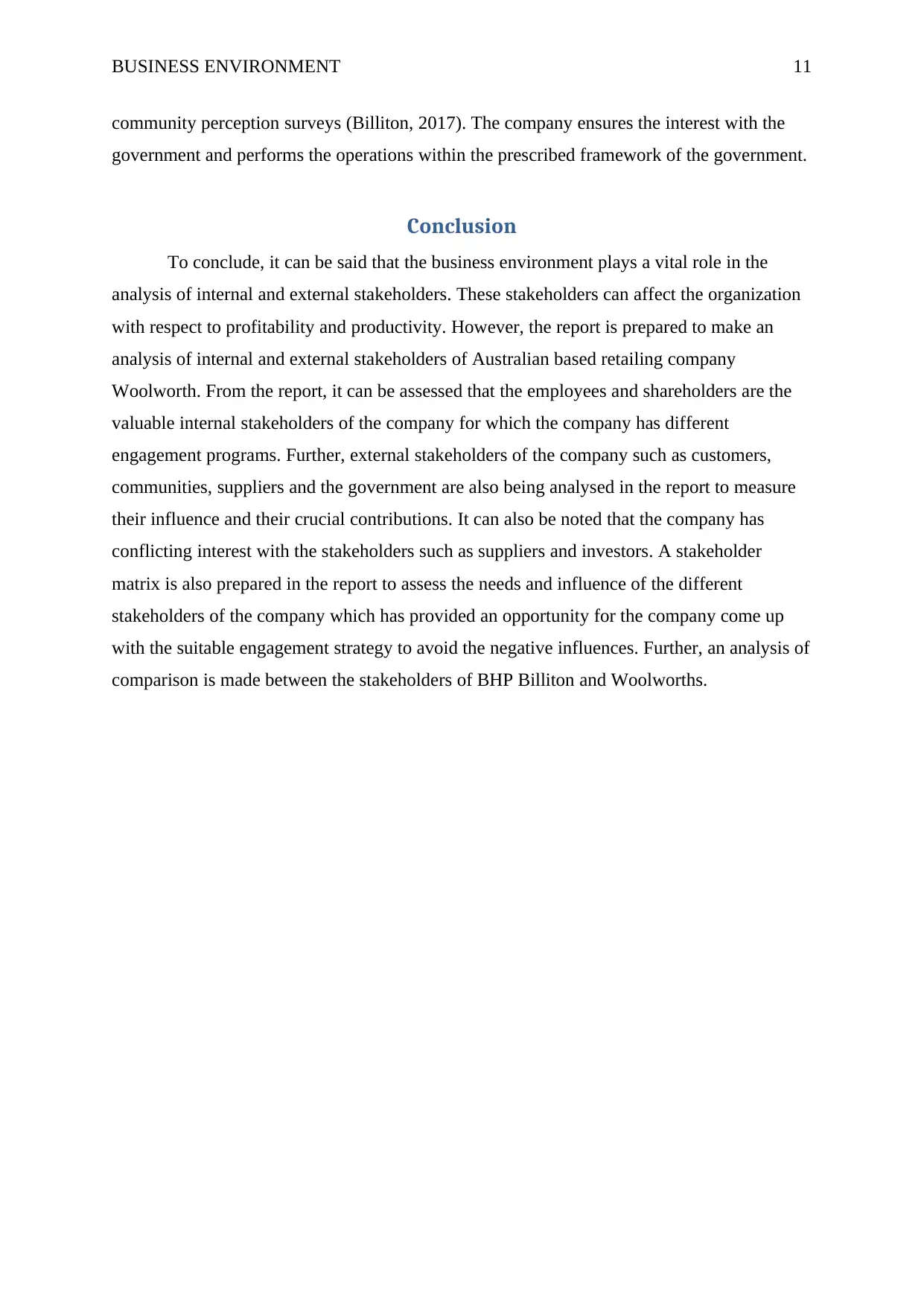
BUSINESS ENVIRONMENT 11
community perception surveys (Billiton, 2017). The company ensures the interest with the
government and performs the operations within the prescribed framework of the government.
Conclusion
To conclude, it can be said that the business environment plays a vital role in the
analysis of internal and external stakeholders. These stakeholders can affect the organization
with respect to profitability and productivity. However, the report is prepared to make an
analysis of internal and external stakeholders of Australian based retailing company
Woolworth. From the report, it can be assessed that the employees and shareholders are the
valuable internal stakeholders of the company for which the company has different
engagement programs. Further, external stakeholders of the company such as customers,
communities, suppliers and the government are also being analysed in the report to measure
their influence and their crucial contributions. It can also be noted that the company has
conflicting interest with the stakeholders such as suppliers and investors. A stakeholder
matrix is also prepared in the report to assess the needs and influence of the different
stakeholders of the company which has provided an opportunity for the company come up
with the suitable engagement strategy to avoid the negative influences. Further, an analysis of
comparison is made between the stakeholders of BHP Billiton and Woolworths.
community perception surveys (Billiton, 2017). The company ensures the interest with the
government and performs the operations within the prescribed framework of the government.
Conclusion
To conclude, it can be said that the business environment plays a vital role in the
analysis of internal and external stakeholders. These stakeholders can affect the organization
with respect to profitability and productivity. However, the report is prepared to make an
analysis of internal and external stakeholders of Australian based retailing company
Woolworth. From the report, it can be assessed that the employees and shareholders are the
valuable internal stakeholders of the company for which the company has different
engagement programs. Further, external stakeholders of the company such as customers,
communities, suppliers and the government are also being analysed in the report to measure
their influence and their crucial contributions. It can also be noted that the company has
conflicting interest with the stakeholders such as suppliers and investors. A stakeholder
matrix is also prepared in the report to assess the needs and influence of the different
stakeholders of the company which has provided an opportunity for the company come up
with the suitable engagement strategy to avoid the negative influences. Further, an analysis of
comparison is made between the stakeholders of BHP Billiton and Woolworths.
⊘ This is a preview!⊘
Do you want full access?
Subscribe today to unlock all pages.

Trusted by 1+ million students worldwide
1 out of 14
Related Documents
Your All-in-One AI-Powered Toolkit for Academic Success.
+13062052269
info@desklib.com
Available 24*7 on WhatsApp / Email
![[object Object]](/_next/static/media/star-bottom.7253800d.svg)
Unlock your academic potential
Copyright © 2020–2025 A2Z Services. All Rights Reserved. Developed and managed by ZUCOL.





